ARCHIVED: Chapter 4: Young people in Canada: their health and well-being – The Peer Group

The establishment of friendships is fundamental to adolescent development. The transition from preadolescence to adolescence brings about a change in the nature of relationships with peers. To address their changing social needs, friendships become more intimate in nature and friends become close confidants (Buhrmester, 1996). Intimacy can be described here in terms of the ease of communication within peer relationships, as well as comfort in disclosing problems and worries with others. Having close friends is associated with positive emotional health and social adjustment. Children with close friends demonstrate better academic performance, lower rates of juvenile delinquency, and lower dropout rates, compared with children who do not have friends as sources of intimacy and social support (Parker and Asher, 1987).
The type of peer relationships, number of friends, and extent of involvement in a peer group evolve over adolescence and may influence the degree to which adolescents become involved in health-promoting or health-compromising behaviours (Sieving, Perry, and Williams, 2000). This chapter explores adolescents' same-sex and opposite-sex friendships, as well as the impact of their friends' involvement in health-compromising behaviours .
Same-Sex Friendships
Most of the students in the HBSC reported having three or more close friends, although this dropped slightly for both genders in Grade 10 (Figures 4.1 and 4.2).
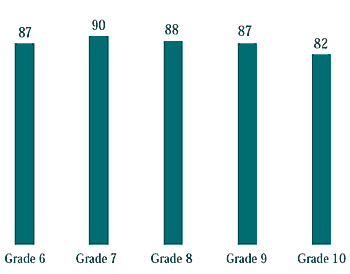
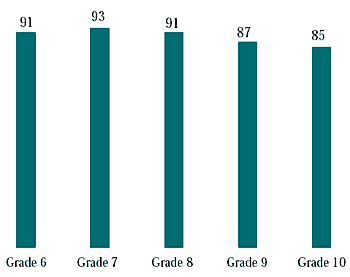
Gender differences often exist in adolescent relationships with same-sex friends. Girls' interactions are usually more personal in nature, involving a higher degree of self-disclosure and emotional support, whereas boys' interactions are "directed toward the enhancement of personal status" (Maccoby, 1990, p.168) and on doing things together (Wright, 1982). In the HBSC sample, more girls than boys at all ages found it easy to talk to same-sex friends about things that bother them (Figure 4.3). This is consistent with research in which boys were found to develop closeness and intimacy with friends more slowly than girls (Sharabany, Gershoni, and Hofman, 1981). As such, same-sex relationships for boys have less emphasis on the affective components and more on the instrumental aspects, such as meeting specific concrete needs and helping each other out when in trouble. In contrast, same-sex relationships for girls are centred around support, help and guidance, and exchange of intimacies.
Figure 4.3 Students who found it easy or very easy to talk to same-sex friends about things that really bother them (%)
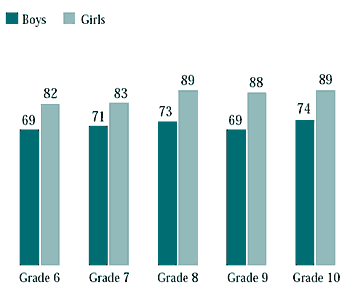
Ease of communication with friends of the same sex declined for boys in Grades 6 and 8 across the first three cycles of the HBSC survey but rose slightly from the 1998 to the 2002 survey (Figure 4.4). For Grade 10 boys, a slight decrease was evident across the four cycles of the survey. Ease of communication with friends of the same sex was lower for Grade 6 girls in 1994 and 1998, and for Grade 10 in 2002 (Figure 4.5).
Figure 4.4 Boys who found it easy or very easy to talk to same-sex friends about things that really bother them, by year of survey (%)
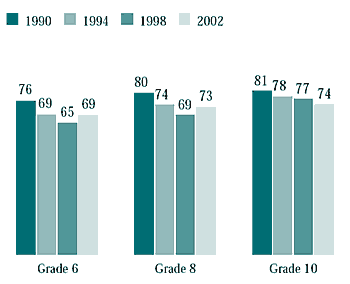
Figure 4.5 Girls who found it easy or very easy to talk to same-sex friends about things that really bother them, by year of survey (%)
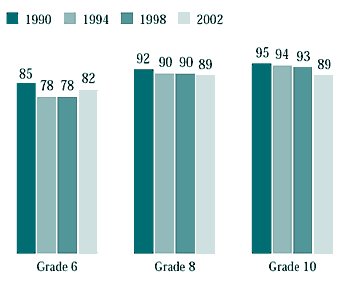
Opposite-Sex Friendships
During the developmental period of adolescence, characteristics of adult intimacy are often initiated. Opposite-sex friendships are considered a more intimate form of friendship and a learning stage for mature sexual relations compared with same-sex relationships (Sharabany et al., 1981). Establishing opposite-sex friendships is critical to the socialization of adolescents away from dependence on parents into their adult roles (Buhrmester, 1990; Kuttler, La Greca, and Prinstein, 1999).
In contrast to same-sex friendships, the proportion of boys in the sample who reported having three or more close opposite-sex friends increased with age. Almost 70 percent of boys in Grades 9 and 10 had three or more close friends who were girls, compared with only 55 percent of boys in Grade 6 (Figure 4.6). However, the pattern for opposite-sex friendships for girls did not demonstrate significant variation across the five grades (Figure 4.7).
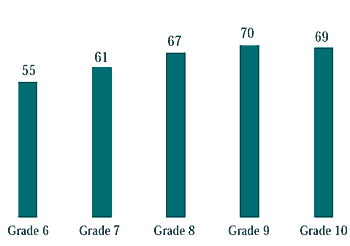
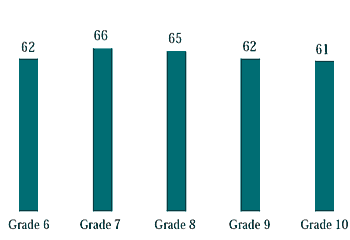
It is important for adolescents to develop intimate relationships within which they learn communication skills and become more comfortable sharing their emotional joys and worries. Similar to findings in literature which shows that both boys and girls are more at ease in same-sex interactions (McBride and Field, 1997), the HBSC data show that both boys and girls were less comfortable in opposite-sex interactions (Figure 4.8) than in same-sex friendships (Figure 4.3). In particular, girls were less at ease talking to boys than to other girls about things that bothered them. Gender differences in communication with members of the opposite sex narrowed for older students. By Grades 9 and 10, almost as many boys as girls found it easy to talk to friends of the opposite sex about things that bothered them. On the other hand, as many as one-third of students in Grade 10 were not comfortable sharing their worries with members of the opposite sex. As both boys and girls grow and gain more confidence and experience less inhibition, they become more comfortable in their relationships with the opposite sex (Lundy, Tiffany, McBride, Field, and Largie, 1998). Ease of communication with friends of the opposite sex remained consistent for boys across the four HBSC surveys (Figure 4.9) but decreased for girls in Grades 6 and 8 (Figure 4.10).
Figure 4.8 Students who found it easy or very easy to talk to opposite-sex friends about things that really bother them (%)
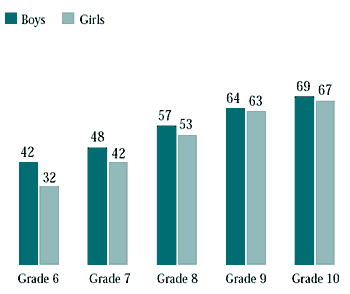
Figure 4.9 Boys who found it easy or very easy to talk to opposite-sex friends about things that really bother them, by year of survey (%)
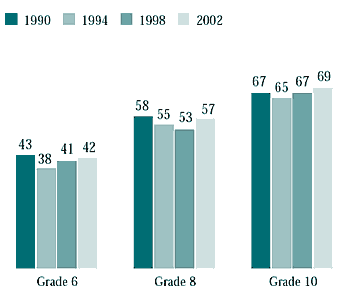
Figure 4.10 Girls who found it easy or very easy to talk to opposite-sex friends about things that really bother them, by year of survey (%)
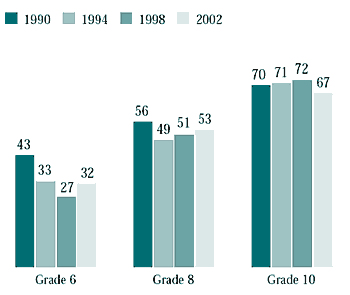
Best Friends
Talking to a best friend about worrisome issues was easier for girls than for boys (Figure 4.11). Yet ease of communication with a best friend improved for both older boys and girls. Research indicates that important changes occur in the nature and significance of friendship during adolescence. These changes are evident in a growth in the level of friendship intimacy as expressed by more frequent exchanges, personal disclosure, and provision of emotional support (Buhrmester, 1990).
Figure 4.11 Students who found it easy or very easy to talk to a best friend about things that really bother them, by year of survey (%)
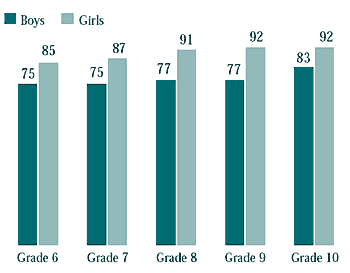
Time Spent With Friends
"Playing together," "hanging out," and "doing things together" are among the most important features of youth friendship (Savin-Williams and Berndt, 1990). Time spent with friends is a good indicator of adolescents' involvement with their peer group. In the HBSC study, the time that boys spent with friends after school (Figure 4.12) or in the evenings (Figure 4.15) was stable across grades. However, girls in higher grades spent less time with their friends right after school (Figure 4.12) and fewer evenings out with friends (Figure 4.15) compared with those in lower grades. This decrease in peer contact could be attributed to parental restrictions on their daughters as they get older or to girls spending more time on schoolwork, part-time jobs or other concerns at home. There appeared to be a downward trend in the proportion of students who spent four or five days a week with friends right after school, or five or more evenings a week, since the 1994 survey, especially for girls in Grade 10 (Figures 4.13 and 4.14; Figures 4.16 and 4.17).
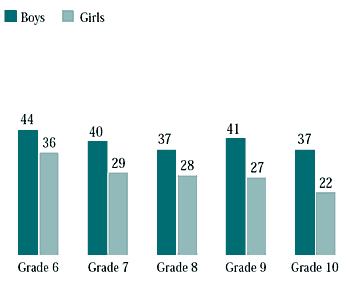
Figure 4.13 Boys who spent four to five days a week with friends right after school, by year of survey (%)
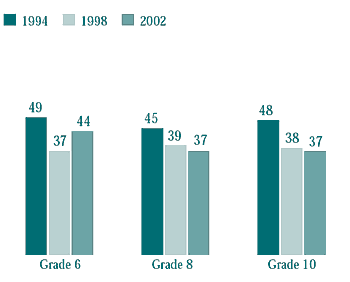
Figure 4.14 Girls who spent four to five days a week with friends right after school, by year of survey (%)

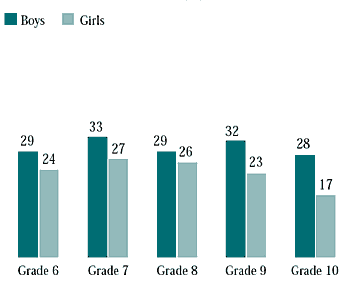
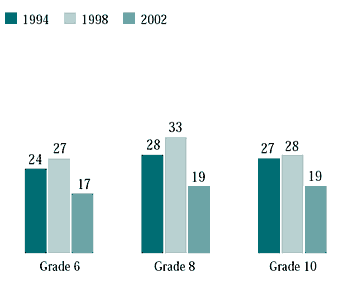
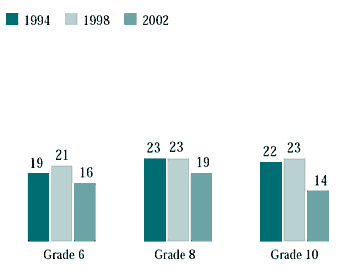
Peer Risk Behaviour and Substance Use
This section assesses the extent of peer involvement in smoking and substance use and the impact of those peer behaviours on students' own risk behaviours. Although more girls than boys in Grade 9 reported having friends who smoked, this situation reversed slightly in Grade 10 (Figure 4.18). The trend is similar for friends' use of drugs, yet the proportion of Grade 10 boys whose friends used drugs to get stoned was significantly higher than that for girls (Figure 4.19). However, the gender difference was reversed for binge drinking; marginally more Grade 10 girls than boys reported having friends who had been drunk at least once (Figure 4.20).
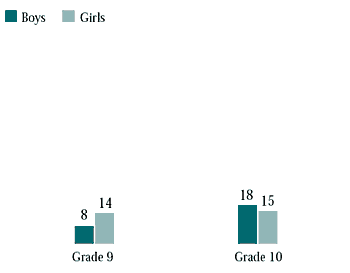
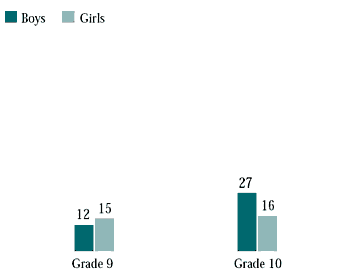
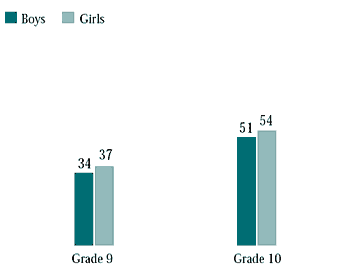
Social Integration and Peer Influence

To help explain the relationship between peer and youth health behaviours, two scales central to adolescent peer relationships were developed. The first, social integration (SI), consisted of items that assessed: (a) the number of close friends from either gender; (b) the degree of interaction, such as the number of days spent with friends after school, as well as communication over the phone or through electronic mail; and (c) the ease of communication and comfort with friends. The second scale, peer influence (PI), assessed: (a) the extent to which friends were involved in risk behaviours; and (b) friends' attitudes toward parents and school. Combinations of high and low levels on these two scales created four categories of students in Grades 9 and 10. These categories were: (1) high SI and positive PI; (2) high SI and negative PI; (3) low SI and positive PI; and (4) low SI and negative PI.
Table 4.1 presents the relationships between each of these four student groups and attitudes, emotional health, and possible health risk factors. Those students who were not well integrated socially and who had negative peer influence (Category 4) were the least satisfied with their lives, least happy with their home lives, and most likely to want to leave home. They were also least likely to enjoy being at school, or to feel they belong at school, and more often reported being lonely and left out of things. However, having positive peer influence improved the emotional state of students who were not well integrated socially (Category 3) and enhanced their attachment to the home and school. Although 31 percent of students in this category reported feeling lonely and left out of things, almost half (47 percent) rated their lives highly on a scale from 0 to 10, and 72 percent said they had a happy home life.
Even if students were well integrated socially (Categories 1 and 2), having negative peer influence increased the likelihood of students smoking, getting drunk, and using marijuana. However, the use of hard drugs, which is regarded as a more extreme form of substance use, was higher for students who were less integrated socially and had negative peer influence (Category 4) compared with those who were well integrated socially but had negative peer influence (Category 2). This implies that smoking, drinking, and marijuana use occur more in socially integrated youth, perhaps in peer social settings such as dances and parties, and that these more common risk behaviours may create a bond between friends (Engels and ter Bogt, 2001).
Finally, having had sexual intercourse at least once was most common among Grade 9 and 10 students who reported high social integration but negative peer influence (Category 2). Having had sexual intercourse was also relatively common among students who had low social integration but were negatively influenced by their peers. Sexual intercourse was least common among students who reported positive peer influence, regardless of the degree of social integration (Categories 1 and 3).
Major Findings
- More boys than girls had difficulty in talking to their same-sex friends.
- The ease of communication between genders was less in lower grades, especially for girls.
- The ease of communication between best friends was less in boys, especially in lower grades.
- Peer contact, both after school and in the evenings, was lower for older girls.
- Social integration of students was linked to high life satisfaction.
- Positive peer influence was related to high life satisfaction.
- Negative peer influence corresponded with risk-taking behaviours in students.
- Minor risk taking occurred more in socially integrated students.
- Major risk taking (e.g., hard drugs) occurred more in students with poor social integration.
- Sexual behaviour occurred more in youth with negative peer influence, regardless of their social integration.